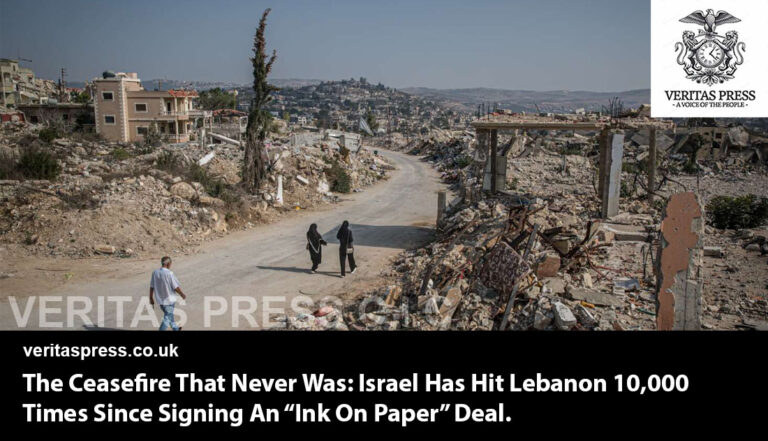Press Release: Veritas Press C.I.C.
Author: Kamran Faqir
Article Date Published: 14 Oct 2025 at 13:10 GMT
Category: Middle-East | Palestine-Gaza-West Bank | Inside Ben-Gvir’s Crusade
Source(s): Veritas Press C.I.C. | Multi News Agencies

Business Ads


An investigation into Israel’s National Security Minister’s repeated incursions into Al-Aqsa Mosque, and how religious theatre has become a tool of state policy, reshaping one of the world’s most volatile flashpoints.
JERUSALEM / LONDON — When Itamar Ben-Gvir, Israel’s far-right National Security Minister, marched through the Al-Aqsa Mosque compound on Tuesday morning, flanked by armed police, trailed by cameras, and smiling broadly beneath the golden Dome of the Rock, it marked his second incursion in less than a week, and his 13th since taking office in 2022.
For Palestinians, it was another calculated humiliation. For Ben-Gvir’s followers, it was an act of sovereignty. For seasoned observers of Israeli politics, it was something else entirely: the latest phase in a long-running campaign to rewrite the rules governing Jerusalem’s holiest site and to cement Israeli dominance over occupied East Jerusalem, one carefully choreographed visit at a time.
A Systematic Campaign, Not A Stunt:
Ben-Gvir’s Al-Aqsa appearances are often dismissed as publicity stunts by a fringe ideologue. But a review of official records, witness statements, Waqf logs, and his own social-media posts suggests a coordinated strategy of incremental annexation, a bid to erode the so-called “status quo” that has, since 1967, governed religious access to the site.
Under that understanding, brokered after Israel’s occupation of East Jerusalem, the Jordanian-run Islamic Waqf retains administrative custodianship of the compound, while Israel controls external security. Muslims may worship there freely; non-Muslims may visit, but are prohibited from prayer or ritual activity.
That arrangement, fragile as it is, has survived decades of conflict. Ben-Gvir appears intent on ending it.
Since October 2023, amid Israel’s war on Gaza, the minister has entered the compound ten times, each visit accompanied by dozens of Jewish settlers, police escorts, and media coverage, and each more defiant than the last.
“Every appearance is a message,” says a senior Waqf official who requested anonymity for fear of reprisal. “He comes not to pray, but to prove that Israel, not Jordan, controls Al-Aqsa. The police clear out Muslims, the settlers perform rituals, and the world watches silently.”
Security Shields For Sacred Theatre:
The incursions are carried out under the full protection of Israel’s security apparatus. During Ben-Gvir’s latest visit, heavily armed police sealed off entrances to the Old City, restricting Muslim access while ushering settler groups through the Al-Maghrabah Gate, the only access point fully controlled by Israel.
Witnesses told Wafa and Anadolu Agency that settlers performed Talmudic rituals, prostrations, dancing, and plant offerings for the Jewish festival of Sukkot, activities prohibited under the Waqf’s jurisdiction.
“Police acted as escorts and enforcers,” said one eyewitness interviewed by Middle East Eye. “They prevented Muslim worshippers from entering while guarding settlers who waved flags and chanted.”
The optics are deliberate: state power protecting settler piety in the heart of Islam’s third-holiest site.
Breaking The Law, And The Protocol:
Israeli ministers are legally required to seek advance approval from the Prime Minister’s Office before entering Al-Aqsa. According to security sources cited by Reuters, no such announcement or clearance was issued ahead of either of Ben-Gvir’s October visits.
That breach of protocol is not trivial. It represents the minister, who once hung a portrait of the Jewish extremist who massacred 29 Palestinians in Hebron, defying his own government’s procedures to advance an ideological agenda: reclaiming what he calls “Jewish sovereignty over the Temple Mount.”
On October 8, Ben-Gvir livestreamed his visit from inside the compound, declaring that Israel was “winning on the Temple Mount” and calling for “complete victory in Gaza.” His message blurred the lines between religious symbolism and wartime propaganda.
“This is a deliberate conflation,” said a former Israeli intelligence officer speaking on condition of anonymity. “He’s using Al-Aqsa as a political stage to inflame nationalist sentiment, pressure Netanyahu, and block any moves toward a ceasefire.”
From Fringe Activism To State Policy:
Once a marginal agitator from the extremist Kach movement, Ben-Gvir has leveraged his position inside Netanyahu’s coalition to transform hardline ideology into policy.
As National Security Minister, he commands the police, including the same units that secure Al-Aqsa. “He has direct operational control over who enters, who’s restricted, and when,” notes Israeli analyst Amir Tibon. “This is not civil disobedience; it’s an institutionalised policy shift.”
The Jerusalem Islamic Endowments Council warned last week that 2025 has witnessed “the worst demolition of Al-Aqsa’s historical and legal status in modern times,” citing “flagrant and unprecedented violations” by Israeli authorities and Jewish extremist groups.
Jordan, which maintains official custodianship of the site, condemned Ben-Gvir’s incursions as “a flagrant violation of international law and the existing status quo.” Foreign Ministry spokesman Fuad Al-Majali reiterated: “Israel has no sovereignty over occupied Jerusalem or its Islamic and Christian holy sites.”
The Organisation of Islamic Cooperation, Saudi Arabia, and the Arab League issued parallel condemnations. But Israel’s far-right ministers celebrated. One coalition partner hailed Ben-Gvir’s “courage to reclaim our holiest place.”
Legal Faultlines And International Exposure:
The International Court of Justice’s July 2025 advisory opinion declared Israel’s occupation of Palestinian territory, including East Jerusalem, illegal and demanded the evacuation of all settlements.
Ben-Gvir’s actions, analysts say, directly contradict that finding. “Every ministerial incursion is a symbolic act of annexation,” said Professor Abeer Baker, an international law expert at Haifa University. “When a government official enters occupied territory, under military guard, to perform religious rites, that’s not worship, it’s an assertion of sovereignty. It deepens the illegality.”
The incursions also violate Article 9 of the 1954 Hague Convention, which obligates occupying powers to protect the cultural and religious heritage of occupied sites.
Despite this, there has been no indication of disciplinary action or restraint from Netanyahu’s office, a silence critics interpret as tacit approval.
An Emerging Two-Track Policy:
Investigators and diplomats alike see a two-track policy emerging:
- Symbolic normalisation: High-profile visits by senior officials, making Jewish prayer at Al-Aqsa appear routine.
- Administrative entrenchment: Security procedures that gradually privilege settler access while constraining Palestinian worship.
In practice, this has already redrawn the lived geography of Al-Aqsa. Police now impose “time windows” for Muslim entry, close gates during Jewish visits, and occasionally deploy crowd-control units to suppress protests.
“These are administrative forms of annexation,” said Khaled Zabarqa, a Jerusalem lawyer specialising in Waqf affairs. “The occupation is no longer about tanks or soldiers, it’s about who has the keys, the cameras, and the power to say no.”
Flashpoint For A Wider Fire:
Jerusalem’s holy sites have long served as catalysts for wider conflict. In 2021 and 2023, clashes at Al-Aqsa helped trigger wars in Gaza.
Today, with Gaza under siege and famine warnings mounting, another provocation risks a wider explosion. Hamas, Islamic Jihad, and other groups have already invoked Ben-Gvir’s actions as proof of Israel’s intent to “Judaize” Jerusalem.
A European diplomat involved in ceasefire talks in Cairo described the minister’s visits as “sabotage by spectacle.”
“Every time there’s progress on hostages or humanitarian access,” the diplomat said, “Ben-Gvir goes to Al-Aqsa. It’s a signal to the far-right base and a grenade tossed into the negotiating room.”
The Road Ahead: Escalation Or Accountability.
Experts warn that continued incursions could set off a chain reaction of regional instability, undermine Jordan’s peace treaty with Israel, and invite international legal scrutiny.
Yet Ben-Gvir appears undeterred. “The Temple Mount is ours forever,” he declared this week, vowing to return again before the month’s end.
For Palestinians, such words evoke a grim historical continuity: the steady hollowing out of promises, protocols, and protections.
“They take one more piece of Al-Aqsa each visit,” said Sheikh Ekrima Sabri, a senior cleric and former Grand Mufti of Jerusalem. “Not with bulldozers, but with arrogance, cameras, and soldiers. And the world calls it a visit.”
What this investigation reveals:
- Ben-Gvir’s incursions are coordinated political acts, not spontaneous visits.
- Israeli police have repeatedly facilitated settler rituals while restricting Muslim access.
- Government oversight mechanisms have been bypassed, with no public record of official authorisation.
- The pattern aligns with a broader effort to erode the Al-Aqsa “status quo” and strengthen Israel’s de facto control over East Jerusalem.
- The incursions heighten regional tension, risk provoking violence, and expose Israel to renewed international legal scrutiny.
Conclusion: The Politics of Desecration.
Itamar Ben-Gvir’s repeated storming of Al-Aqsa Mosque is no longer the act of a lone extremist testing limits; it has become the theatre of a much larger policy: the fusion of religious symbolism with state power to achieve what decades of diplomacy and war have not, the unacknowledged annexation of occupied Jerusalem.
Every police-guarded step he takes inside the compound reaffirms that process, narrowing the space for moderation, diplomacy, and coexistence. And as the world watches yet another “visit,” the line between worship and domination fades, leaving one of the world’s holiest sites hostage to the politics of provocation.
Each incursion follows a familiar choreography: police sealing off Muslim worshippers, armed escorts shielding settlers performing banned rituals, and the minister himself posing beneath the Dome of the Rock as though claiming dominion. These are not random provocations but performances of annexation, staged acts of sovereignty meant to collapse the historic “status quo” and replace it with a new reality of exclusive Israeli control.
Ben-Gvir’s repeated defiance of legal and diplomatic protocols signals a systematic erosion of the Jordanian Waqf’s custodianship, an assault on the international legal order that safeguards occupied holy sites. The International Court of Justice’s July 2025 ruling, which declared Israel’s occupation of Palestinian territory, including East Jerusalem, illegal, has been treated with the same contempt as every other global rebuke. Under Ben-Gvir’s watch, violations are not hidden but performed publicly, under cameras and police shields, as deliberate demonstrations of impunity.
This spectacle has become the ideological centrepiece of the far-right project inside Netanyahu’s coalition: to transform religious extremism into a policy of territorial entrenchment. What once existed on the margins of Israeli politics, the dream of rebuilding a Jewish temple atop Al-Aqsa, is now creeping into the language of ministers and the daily routines of state security. Each visit, each ritual, each “plant offering” carried through Al-Maghrabah Gate is a symbolic test of global tolerance, and so far, the world has failed it.
But what unfolds at Al-Aqsa is not simply a question of faith. It is the weaponisation of religion to justify permanent occupation, a slow-motion rewriting of Jerusalem’s geography and memory. It is the use of sacred space to perform political supremacy, where worship becomes domination, and devotion becomes desecration.
Ben-Gvir’s campaign marks a turning point: the replacement of diplomacy with divine entitlement, of law with spectacle. In this dangerous inversion, the sacred is no longer protected but exploited, turned into a stage where nationalism masquerades as faith, and violence as prophecy.
If unchecked, this project will not only extinguish the sanctity of Al-Aqsa but unravel the last fragile threads of coexistence in Jerusalem itself. What we are witnessing is not the preservation of belief but its manipulation as a weapon of rule, a desecration of history, justice, and humanity in the name of God.
The consequences are already rippling beyond Jerusalem. Jordan’s custodianship, a pillar of the 1994 peace treaty, is under unprecedented strain. Each new raid deepens regional mistrust, fuels extremism, and undermines U.S. and European diplomacy in an already volatile landscape. Within the international legal system, pressure is mounting for the International Criminal Court and United Nations bodies to treat Ben-Gvir’s actions not as isolated provocations but as state-sanctioned violations of the laws of occupation.
If the world continues to respond with silence and statements, Jerusalem’s future will be decided not in courts or peace conferences, but on the stones of Al-Aqsa itself, where power, once again, has replaced prayer, and impunity has replaced faith.

























